Return to Auschwitz: How Israel keeps Holocaust memories alive
- Published
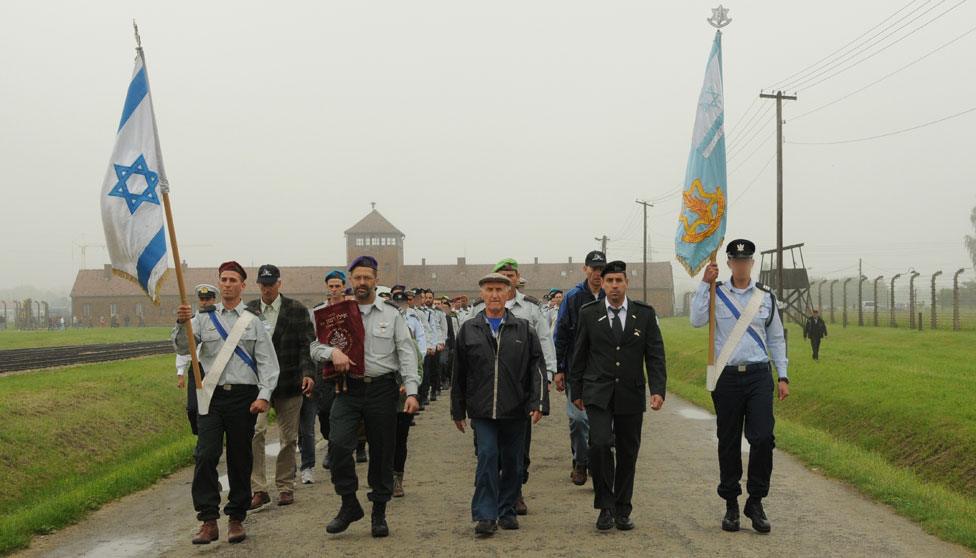
The number of people who survived the Holocaust is dwindling - they are all now old men and women. But the Holocaust carries a special importance for Israel. Can it ensure that the next generation knows, and does not forget, what happened in Europe seven decades ago?
Under a lightless Polish sky as dull and flat as a sheet of beaten lead the Israeli flag flutters listlessly in the light wind.
There are not many touches of colour to be seen at the gates of Auschwitz and the blue Star of David stands out on its crisp white background.
The Israeli soldiers carrying the flag have not come as tourists of course - they are here as an official military delegation to learn the lessons of the Holocaust and to piece together fragments of family histories that were shattered by war and by genocide.
To the foreign tourists they are something of an attraction. German, Polish and Japanese visitors film the scene on their mobile phones as the Israelis parade alongside the railway tracks on which the Nazis brought more than a million Jews to their deaths.
There are moments when the Israelis look like tourists themselves with their cameras and their tour guides - but their government sends them here with a purpose. It believes that deepening their knowledge of the Holocaust will deepen their commitment to defending the country.
Behind them is the grimly familiar brick building with a high archway under which the trains slowed to a halt as they reached the end of the line.
The Israeli delegation is marching in the footsteps of the many Jews who took their last steps here.
This is the spot where German SS officers rapidly assessed which prisoners looked fit and strong enough to be sent to the wooden blockhouses where the slave labourers lived. The Germans had taken a timber building originally designed to house about 50 cavalry horses and adapted it to the demands of the prison camp. Four hundred prisoners were crammed into the same space, packed on to double-decker bunks. In freezing rooms on starvation rations only a few lived for more than a few months.
The rest were herded towards the gas chambers.
It was murder on an industrial scale - whole communities perished together within hours of climbing down from the trains.
So the most moving moment in the Israeli soldiers' journey comes inside one of the old blockhouses, where a handful of them read out loud lists of the names of family members who died in the Holocaust.
Sometimes almost nothing is known to tell the stories of lives that were not lived, except a name.
As Yishai Szekely - a doctor who serves as a reserve officer in an artillery unit - explains, in some families first-hand memories are passed down. There are photographs or books and ornaments with stories attached, that make the dead seem real.
Here, the reading of the names is the only way to reclaim the dead from the anonymity of genocide.
"Six million is such a huge number, even to think of 1,000 it confuses you," Szekely says. "The power is in the name because we don't have much left. That's the only thing we can touch or understand or imagine, our only connection that we could start to make to our past… When you connect to one name, one person to one name, it makes it easier for you to understand."
When the last name has been read, I stroll between the blockhouses with Yechiel Aleksander, who was brought to Auschwitz as a teenager in 1944, on one of the Eastern Transports - the trains that carried the Jews to the selection process between life and death.
He survived of course and went to Israel after the war.
This is his 35th trip back to Poland with Israeli delegations to deliver lectures about what life was like here and to answer questions when he can.
The first nine or 10 trips back here affected him very badly, he says. For a moment, switching between Hebrew and the fluent Polish he still remembers from childhood, he is lost for words. He describes how the visits depressed him, by holding his hand out straight and level and then suddenly bringing it down in a plunging, swooping motion.
He still comes, though. He believes that those who know what it was like here have a special responsibility towards those who do not.
He remembers discussing the expulsion of the Jewish community from Spain at the end of the 15th Century with a group of Israeli schoolchildren and realising that most didn't know anything about it.
What, he wondered, if the Holocaust were to be forgotten in the same way, two or three generations from now?
"In 1994 I promised that all this must remain for future generations. I thought [if things remained the way they were] that in two generations from now no-one would even know that this place existed. It's much easier now that I know I'm passing things on to youngsters. Perhaps it will stick now and each generation will pass it on to the next generation."
Yechiel leads me to an open pool of water with deep concrete sides, on a grass verge beside the blockhouses - the kind dug to give firefighters access to an easy supply of water for emergencies.
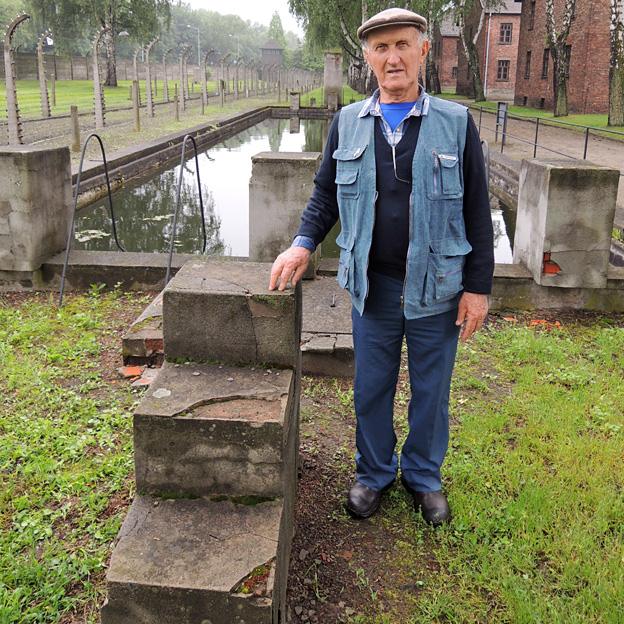
He tells me that one day in August 1944 he was among a group of slaves ordered to help make a set of concrete steps to stretch down inside the water to the floor of the pool. The SS, it seemed, wanted somewhere to go swimming.
The story is grim and bizarre - and it tells you a lot about the mood of the German officers working at the camp in the late summer of 1944.
There is the arrogance and inhumanity of wanting a swimming pool to be built just a few hundred metres from the gas chambers and crematoriums of the Holocaust of course.
But that aside, you do find yourself wondering how the Germans can have been thinking about the construction of a swimming pool in the month when the Americans liberated Paris and the Russians began closing in on Warsaw, just a few hundred kilometres north of Auschwitz.
The Germans had planned to carry out the Holocaust under the darkness of a brutal military occupation in some of the most remote parts of Europe. Surely they must at least have begun to fear, as the Nazi armies were pushed back, that their crimes would be detected and punished?
It is a small but telling detail from history. And we know it only because Yechiel Aleksander was there.
At one point in the Israeli delegation's journey through Auschwitz he delivers a speech inside one of the preserved wooden blockhouses, with the soldiers grouped around him.
He is a good talker too. It is tough in those circumstances to find the variation of light and shade to make a speech compelling, to hold an audience, but this is an extraordinary performance - a shaft of light that illuminates the darkness through which he lived.
When it is over I ask Yael Sela-Arbel, a captain, what difference it makes to hear the story of the camp first-hand from a survivor.
"I've been crying a lot," she says. But just being there, for her, has been important.
"I think it's a way of saying that even though everything was done to erase this nation, it's living, so it's a private victory and a national victory, our country, our achievements. It's a way of saying: 'Here we are - you wanted to erase us but here we are, we are strong, and we are capable and advanced and we are everything the people who you murdered expected us to be.'"
Any period of history changes when there is no-one left alive who remembers it at first hand.
I can remember writing stories back in 1998 about the 80th anniversary of the end of World War I when you could still talk with men who'd fought on the Somme or at Jutland, and with the women who had nursed them.
Fifteen years on from that moment, they are all gone.
And who knows, perhaps 15 years from now all the Holocaust survivors will be gone too.
Yechiel Aleksander feels that those who endured these horrors have a special responsibility to talk about them.
When you meet him, you are reminded that the rest of us have a special responsibility to listen.

Before we left Israel for Poland I wanted to try to understand a little more about the role the survivors play in passing on the memory of the Holocaust.
I spent some time with Asher Aud, who lives with his wife in a homely apartment in a block of sheltered living units in the middle of Jerusalem.
His wife, Haya, likes to paint, and she loves her grandchildren. Those two passions have between them filled almost every available inch of hanging space with pictures and photographs.
Your eye is drawn though to a wooden panel that Haya made to mark her husband's 70th birthday, on which scenes from his life are etched into the wood in brightly coloured inks.
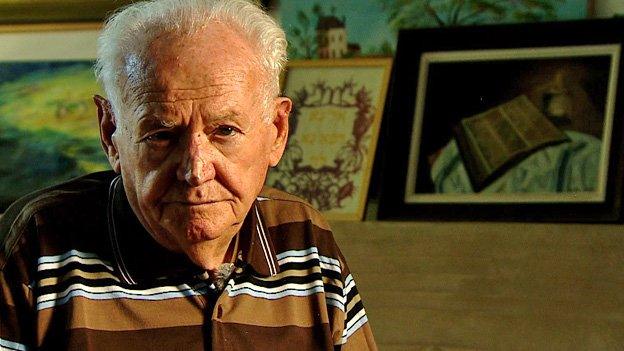
One panel, decorated with rings and hearts, marks the day they married. Another records the births of each of their four children.
A third commemorates Asher Aud's time in Auschwitz.
Just above the biographical panel on the wall is an old-fashioned chiming clock with one of those old-fashioned movements of weights and springs that mechanically chops each day into minutes.
There are nights when Aud hears every one of those minutes measured out. Even when he manages a little fitful sleep he knows, without checking, exactly what time it is when he wakes up.
It is a legacy of the camps. Maybe the superhuman watchfulness that helped you to stay alive, maybe a kind of anxiety that seeped into the soul in those years of terror and never left. Either way it is there.
The cold seeped into his bones too. As the Germans retreated westwards from the advancing Russians in the bitter winter of 1944/45 they took the survivors from the camps with them.
They wanted to stop them testifying to the Russians about what had happened in places like Auschwitz of course, but they also intended to put the prisoners back to work at camps deeper inside German territory.
Aud can remember at one point collapsing into the snow and ice wearing only a thin shirt and pair of trousers and knowing that he would die if he stopped moving and surrendered to the numbing cold. He remembers wriggling desperately to stop his skin from freezing to the icy ground. When he's back in Poland even in August he finds himself wrapping up warm against the chill that only he feels - like the anxiety the cold must have soaked into him and never really left.
He goes back often. He's one of a group of survivors who accompany the many Israeli delegations - schoolchildren, civil servants and soldiers - who now visit the death camps every year.
Like a lot of other survivors, he feels a responsibility to keep the memory of the Holocaust alive.
As time passes their numbers are steadily dwindling.
There are very few people alive who remember the German invasion of Poland in September 1939 as adults.
Even to remember it as a child - to have been 10 years old, for example, when the war ended in 1945 - you must be nearly 80 years old.
In the future you will still be able to read what happened when the Germans came in September 1939 to Aud's home village of Zdunska Wola in central Poland - the public hangings of Jewish community leaders, the beatings and the systematic looting of Jewish homes.
To hear it at first hand is different.
Aud tells the story in English in short phrases. He pauses every now and then as though searching for words that will make it all seem comprehensible to someone who never lived through it, who wasn't there.
But there are no such words.
What words could there ever be to describe the last day he saw his mother alive, 74 years ago.
Asher Aud's family were forced into a field outside Zdunska Wola with the rest of the village's Jewish community. Many of the men had already been murdered, including Asher's father.
Aud himself, although he was only 11 years old, had managed to prove to the Germans that he was strong enough to work in a construction gang. The judgement that he was fit enough for slave labour as a child saved his life.
The Jews of Zdunska Wola were formed into a single long line and ordered to parade past a group of German soldiers. There was more casual brutality of course - they were kicked or punched or hit with rifle butts as they filed past. But this wasn't just another exercise in casual humiliation.
Every so often someone would be pulled from the line and ordered to stand to one side. Aud was among this group. His mother and younger brother were not. They walked on, away from him. He never saw either of them again.
Aud had been selected to join a slave labour gang in the camp at Auschwitz.
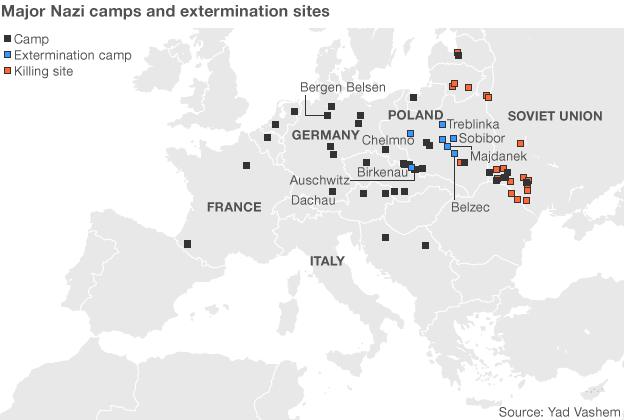
His mother and brother were taken to Chelmno, a camp where the Nazis were making their first experiments in the mass murder of Jews deemed unfit for work.
His voice as he tells the story is steady but his eyes are distant. Every time he describes that day he is reliving it all, the sounds and smells of the field extraordinarily vivid.
He understands the value of telling his story - he sees it as a duty. But it doesn't get any easier with the passing of time.

Modern Israel sees in the Holocaust a clear message for the modern world - that the Jewish people are only safe if they have their own state, a state that has to be strong.
Holocaust survivors are honoured - valued as first-hand witnesses to the great horror that is one of the defining events of modern history.
That wasn't always the way. I was a little surprised to discover that when Asher Aud decided to see a psychotherapist he had to pay for the sessions himself.
They didn't help much. What could any therapist say to a man who'd seen such terrors? But it's interesting that Israel's government didn't feel it had a responsibility to pay.
The truth is, the legacy of the Nazi attempt to wipe out the Jews of Europe wasn't always seen with such clarity.
The new state of Israel absorbed the survivors of the camps - DPs, or displaced persons, in the jargon of the post-war era - but the process wasn't always easy or smooth.
The historian Tom Segev describes the difficulties in his book The Seventh Million - in particular the cultural and political gulf between Israelis who had migrated to the region as a political choice in the 1930s and those who came after 1945, in the chaos and devastation of the immediate post-war period.
He explains it like this.
"In the first years after the Second World War in Israel the Holocaust was very little talked about - in effect it was a taboo. Parents didn't talk about it to their children and children wouldn't dare to ask. It was a period I describe as The Great Silence."
In part the sheer immensity of the Holocaust - the weight of the violence and depravity - made it incomprehensible to anyone who hadn't lived through it.
Segev argues that the Zionist pioneers who had come to the Middle East to build a new type of Jewish society couldn't understand why the European Jews who were murdered hadn't resisted Nazi rule.
Why, in the historian's words, had they "walked like sheep to the slaughter house"?
The truth was of course that Hitler's Germany had perfected a brutal version of totalitarian rule in which effective resistance was almost impossible. But it may have been impossible to understand that too.
There was also a human dimension to that political gulf between the survivors and the rest of Israeli society.
Tom Segev explains it like this: "Even if you leave the ideology aside, how do you relate to someone who has that blue number on his arm? You open your door in the morning and your neighbour has that blue number on his arm - what do you say? How do you live with such a person? Do you want them to tell you what happened to them?"
Too often in that immediate post-war period, the answer it seemed was that people did not want to hear those stories.
The book The Seventh Million chronicles the story of the 81st blow.
A young Holocaust survivor made his way to Israel and described what had happened to him in his concentration camp, of how the commandant had beaten him senseless, landing 80 blows on his head and body.
He found that his story was doubted, disbelieved.
Surely, it was reasoned, if he'd really been beaten so extensively he would be dead.
That scepticism, that downright disbelief, was the 81st blow.
A great deal has changed since then. Israel's national memorial centre at Yad Vashem on the hills outside Jerusalem is a thriving centre of research as well as a moving museum to which all important foreign visitors are taken.
It is working to improve our historical understanding of what happened during the holocaust and to improve the way the subject is taught. And in parallel with those tasks the simplest and saddest job of all continues to this day - the job of recording the names of the individuals who died.
Yad Vashem
Picture credits: Getty Images, Noam Sharon; Voice: Avner Shalev
Yad Vashem's chairman Avner Shalev tells me that in the immediate post-war years only a few survivors' stories were published. Today more than 11,000 memoirs have been produced all over the world - more than half of them since the turn of the century.
The change in attitudes towards holocaust survivors started in 1962, when Israeli agents found Adolf Eichmann living in Buenos Aires.
Eichmann was a bland colourless figure, but he was also one of the architects of the Holocaust. The Israelis kidnapped him, brought him to Jerusalem and put him on trial. He was eventually hanged as a war criminal.
His trial began a kind of national catharsis and the survivors' stories of suffering and barbarism began to be heard more widely.
Israel's founders had mentioned the Holocaust in their declaration of independence back in 1948 but it was the prosecution of Eichmann that placed the suffering of the survivors at the centre of national life.
A lesson began to crystallise, not just about the need for Israel to be strong, but for the Jews of the world to recognise that they couldn't depend on anyone else to guarantee their safety.
Even during what Segev calls the Great Silence, some Israeli families had been piecing together fragments of evidence about the fate of those who died.
A few years ago the Israeli newspaper Yediot Ahronot published the extraordinary story of a photograph which hung on the wall of the office of Meir Dagan, who rose to become head of Mossad, Israel's external intelligence agency.
It is a slightly battered black-and-white print showing a scene from 1942 in the village of Lukow in central Poland. An older Jewish man is kneeling on the floor surrounded by German soldiers.
It is Meir Dagan's grandfather, who is known to have been murdered a short time later.

The picture came to light when Dagan's father returned to his home village after the war, to look for Jewish survivors.
They asked a local Polish man to take some photographs. When he handed over the film roll and they eventually had it processed, they discovered at its start the picture of the Germans surrounding the helpless old man. The photographer must have been taking photographs for the newly-arrived Nazis too.
The photograph is appalling, but it's historically interesting too.
The young Germans are not Aryan supermen but ordinary soldiers called up into their reserve infantry battalions for service in Poland.
It's worth examining the soldier's attitudes - they do not look to me like men who feel they've been caught doing something reprehensible. They look like men posing for a photograph which they intend to display on the mantelpiece in years to come.
Meir Dagan rose to become one of the most powerful men in Israel and throughout his career he had the photograph of his grandfather and the Germans on the office wall.
The lesson he reads into it is simple: "We have," he tells me, "no choice but to rely on ourselves... and there's a hard moral lesson from the Holocaust that anyone could become a murderer. The killings weren't carried out by fanatics but by what might be called normal men."
Outsiders may ask if there isn't a downside to the way in which Israel draws a lesson about the need for eternal vigilance from a story of such unremitting darkness - but it's not a point of view you hear very much in Israel.
Meir Dagan drew that clear connection between the vulnerability of the Jews in German-occupied Poland in the 1940s and the defence of the modern Israeli state.
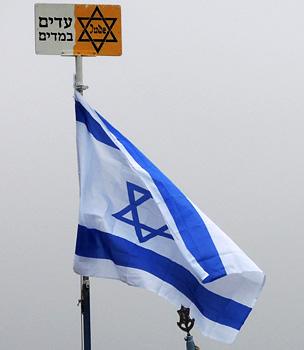
He is not alone in that. When the current prime minister Benjamin Netanyahu talks about Israel's determination to prevent Iran from acquiring nuclear weapons he couches it in terms of a determination that there will never be another Holocaust.
When the Israeli delegation gathers towards the end of the day in Auschwitz I notice another reminder from history.
They have a portable flagpole on which they raise the Israeli flag, and at the very top there is a decal which on one side has the markings of the Witnesses in Uniform programme.
This is the 184th such military delegation to come here, and when you add to that number the many school trips from Israel, you begin to realise that a large and growing section of the population has made this pilgrimage.
Beside the unit's own marking, though, is a copy of the yellow star badge that German occupiers made the Jews of Europe wear on their clothes. It's marked with the word "Jude" (Jew in German) just as the badges were back in the 1940s.
Of all the echoes of the past that the delegation's tour awakens, it is one of the sharpest.

Behind every story of survival in the Holocaust lies a miracle of good luck - something to make you reflect on the randomness and fragility of all of our lives.
If you were taken to a camp like Auschwitz in late 1944, for example - just a few months before it was liberated by the Red Army - you stood a much better chance of surviving than the families who came on the transports in 1942.
The real story of the Holocaust of course is the story of those who did not survive.
In Kielce on the Israeli delegation's long coach journey through Poland from Warsaw to Auschwitz I spend some time with Brigadier General Royi Elcabets, its commander.
He speaks with huge passion about the overall political lesson of such visits - Israel's need to be strong - and a personal moral he draws himself about the special need for Jewish families to invest in their children and in the future.
His grandmother came from Kielce.

As darkness began to fall across Europe in the 1930s she fled to France and endured a desperate and dangerous war that would make a compelling story in itself.
Of her large extended family that stayed behind in rural Poland, not a trace remains.
All we know for sure is that they vanished into the flames of the Holocaust. They were probably taken to Auschwitz because it was the closest of the camps.
General Elcabets sees himself as a kind of bridge between the past and the future.
His grandmother died in the 1990s but she passed on her knowledge of the relatives who died to him, and he in turn will teach his children.
When the time is right, he will bring them to Poland.
"Obviously I will come with them - I think they're waiting for it," he tells me. "I think it is very important for the next generation to have the memory and the knowledge of the holocaust and its implications. I will transfer the knowledge. It's my duty as a father."
General Elcabets isn't alone in those sentiments.
In 2009, the Israeli Institute for Democracy conducted an opinion poll asking Israeli Jews if they agreed with a number of general propositions about the Jewish state.
The need to remember the Holocaust came first, with a score of 98%.
For the general's family at least, the next link in the chain at least seems secure. He tells me proudly that his son has decided to adopt a Holocaust survivor as part of a school project - he at least will hear the stories at first hand.
Not everyone who survived the camps finds it possible to go back.
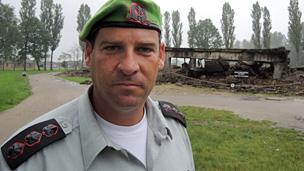
Colonel Aviv Reshef
Beside the ruin of a gas chamber in Auschwitz (the retreating Germans dynamited them to destroy the evidence of their crimes) I meet Aviv Reshef, a colonel in the Israeli parachute regiment.
His grandmother Lily Fisher arrived here with her family on one of the stinking, suffocating cattle trains. Lily was selected for slave labour - her mother, father, brothers and sisters were sent directly to the gas chamber. She watched them being herded through the camp and she never saw them again.
Lily thinks the shock and stress of returning to this place of suffering and loss would be more than she could bear. So before he set off from Israel Aviv called her to ask if she wanted to write a note or light a candle for that lost family for him to take back and leave in the place where they were murdered. After a little thought, she decided that she did not.
"I asked her if she wanted to write something because every one of her family were murdered over here," he explains. "She thought about it for a couple of minutes and she said, 'You are my note, you are my candle... that you're going back there to Auschwitz as an officer in the Israeli Defence Force (IDF), walking into this hell, this is the note this is the candle for me, that means that I won, they wanted to kill me, they wanted to kill my family, but my family still lives."
I find myself asking most of the officers who had made the trip if the survivors they knew personally ever came back.
The most interesting answer comes from a young officer called Itai.
I sit with him in a cafe in the main square at Krakow - a city not far from Auschwitz - which has somehow, miraculously maintained its ancient elegance in spite of Poland's tragic and turbulent history as a crossroads of European violence.
It was Poland's tragic fate to swap years of Nazi occupation for decades of Soviet oppression after the Red Army "liberated" Eastern Europe.
Travel here wasn't impossible during those dispiriting years, but it was not easy either.
Once communism collapsed, Itai's grandmother began coming back on holiday visiting the beguiling summer mountain resorts of southern Poland.
Eventually she brought Itai too.
"She comes to a resort in southern Poland, a very beautiful place and one year she decided that she had to take us with her to see it and to feel Poland as she used to see it before the war. I actually think that she still feels a lot of good things about Poland. She loved being here, she loved growing up here and she still speaks Polish with her friends in Israel although she knows perfect Hebrew."
Interestingly, Itai's grandmother never wanted to bring him back to the scenes of the Holocaust - although she is proud that he has returned with the IDF.
She escaped from the Germans by heading east through Russia to the great Muslim cultural capital of Bukhara in Uzbekistan where more than one family of Polish Jews found help, and shelter and protection. She lost almost everyone she knew and does not want to delve into the past.
"It is very, very hard for her to talk about it," Itai says. "I tried not to push her too much because when you can see the tears in your grandmother's eyes, you try not to push her into it."
Every survivor, every fugitive, has their own way of dealing with the darkness of the past.
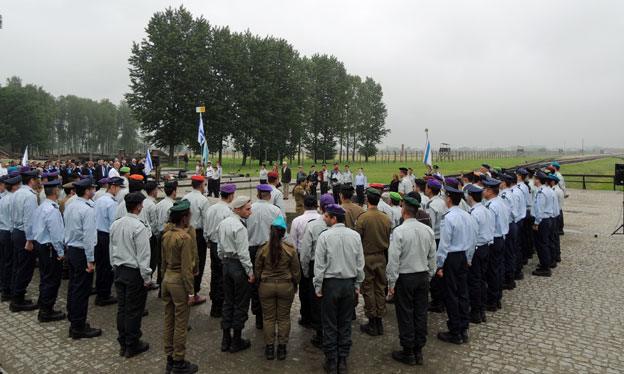
Towards the end of their day in Auschwitz, the Israeli officers conduct a service rich in patriotic symbolism. The Star of David is raised and the national anthem HaTikvah is sung.
But as the last of the pale grey light recedes from the cloudy skies, I find the moments before and after the official service most compelling.
As they began to gather for the ceremony one of the Israeli guides takes out her smartphone and plays a recording of an old Jewish song - Mein Shetetle Bellse - in the dwindling light.
It has been heard here before. In 1944, an SS officer overheard a 16-year-old Jewish orphan called Samuel Gogol playing it - and then forced him to play it again as families were herded along the last short walk to the gas chamber. It was apparently thought to make it easier to handle the crowds.
It is a mournful song whose sobbing phrases would be redolent of regret even in the most cheerful of places.
Here in the heart of darkness, to listen in the same place where it was played 70 years ago, is to listen to an echo of history.
While it is being played I notice that Yechiel Aleksander has wandered off to be alone for a moment.
When he is lecturing and when he is in company he is a compelling speaker - and something of a joker too, who enjoys surprising you with an irreverent wit.
On his own, as the last light leaves the sky he seems lost in sadness. He comes here to tell his story of course - and we come here to listen - but there must be things that only the people who were here could ever understand.
When the service is over some of the Israeli soldiers light candles and place them on the railway tracks that brought so many of the Jews of Europe to their deaths all those years ago.
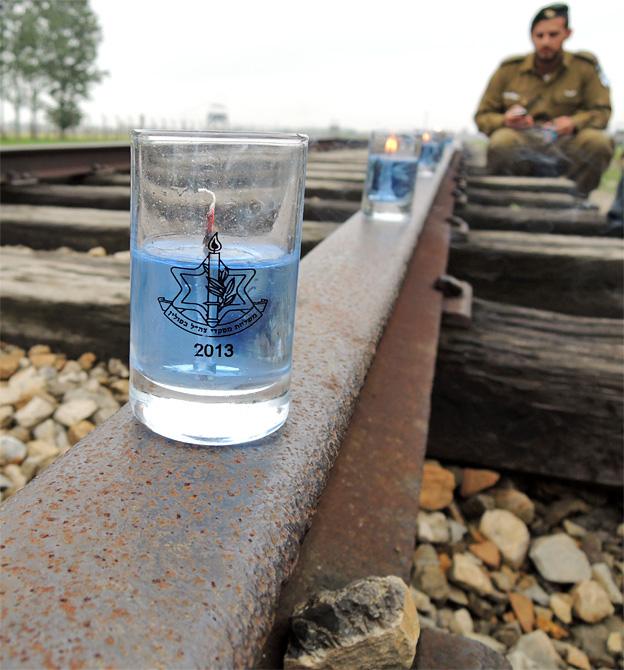
With the forbidding arches of the old Auschwitz railway building in the background it is, everyone agrees, an "iconic" image. Almost everyone pauses to photograph it.
It strikes me that there is something more in the moment too.
The tiny flickering lights stretching down the railway lines into the dark distance remind me of the way men and women suffered here and have somehow come through it.
Auschwitz is of course a warning from history.
But in the ability of people like Asher Aud and Yechiel Aleksander to endure, to survive and to remember it is an inspiration for the future too.
You can follow the Magazine on Twitter, external and on Facebook, external
Some images of soldiers' faces have been blurred to protect their identity, at the request of the IDF.



